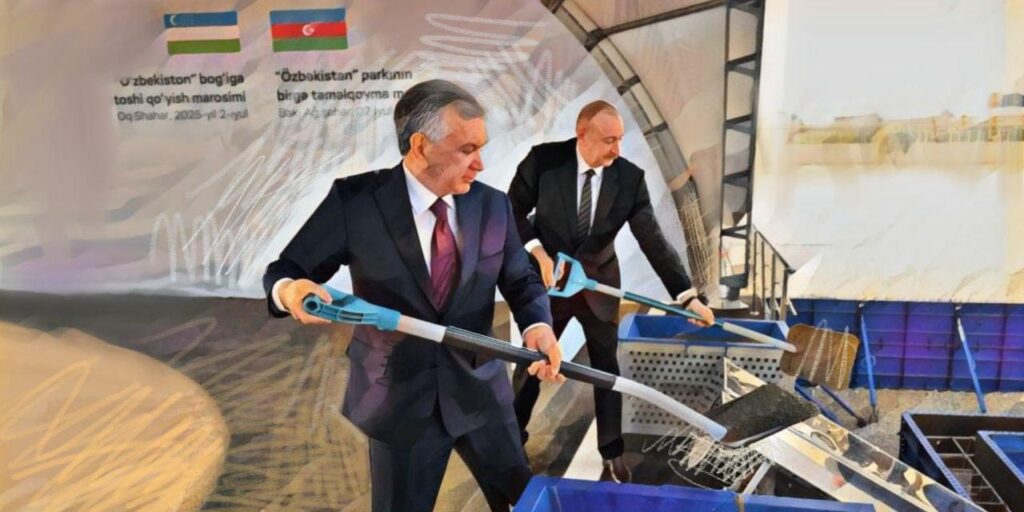Uzbekistan has been working to enhance its role in the Middle Corridor, also known as the Trans-Caspian International Transport Route (TITR). This push reflects Uzbekistan’s strategic aim to diversify trade routes and reduce dependence on Russia. However, it is not just a diversification effort. It is an aspirational strategic pivot whereby Tashkent seeks to recalibrate its position and enhance its resilience within the ongoing geoeconomic restructuring of Eurasian trade.
In January 2025, President Shavkat Mirziyoyev outlined a five-year plan to upgrade infrastructure and streamline trade. The measures enumerated in the decree include improving road and rail connectivity, expanding truck stops, and enhancing border-crossing efficiency at key points.
Uzbekistan’s infrastructural investments, diplomatic realignments, and institutional relations with regional stakeholders reinforce one another. Moreover, they are co-dependent mechanisms in a larger recalibration of Eurasian trade. Azerbaijan is a case in point. The diplomatic realignment under way was exemplified in August 2024, when Uzbekistan and Azerbaijan signed their bilateral Treaty on Allied Relations, which supports infrastructure projects and the amelioration of trade coordination.
In this connection, Uzbekistan is currently investing $18 million in construction of logistics terminal in the Poti Free Industrial Zone in Georgia, an initiative that could streamline transit to Europe, provided that regulatory alignment keeps pace. The country’s increased reliance on Georgian ports has paralleled efforts to coordinate rail administration across multiple transit states. So in September 2024, Uzbekistan took a decisive step by co-founding the Eurasian Transport Route Association along with Austria, Azerbaijan, China, Kyrgyzstan, Tajikistan, and Turkey. These partners are converging on a framework to standardize freight policies, minimize regulatory unpredictability, and optimize throughput along the corridor.
As a demonstration of the corridor’s expanding logistical reach, Uzbekistan dispatched its first block train to Brazil in December 2024, demonstrating the potential for new international market connections through modular trade integration. The container train carried 28 tons from Tashkent through Turkmenistan, Azerbaijan, and Georgia before reaching Brazil by sea. Following a similar strategy, earlier this year, at the end of January in Ankara, Uzbekistan participated in its second trilateral meeting with Turkey and Azerbaijan, focusing on developing trade, investment, and transport links through the Middle Corridor.
A set of interdependent “adaptive constraints” (in systems-theory language) constrains the Middle Corridor’s long-term viability. For example, infrastructure bottlenecks do more than cause delays. They exacerbate cost unpredictability, instilling hesitation among investors, who remain wary of investment to an unpredictable transit network. Such reluctance to commit capital in turn limits the very infrastructure improvements needed to resolve the said bottlenecks.
To overcome these challenges, Uzbekistan is investing in infrastructure improvements, in the expectation that these will help attract foreign direct investment while also improving trade efficiency over time. Yet beyond the standard geopolitical risks of political instability in transit countries, shifting geoeconomic alignments, and competition from other routes, there are infrastructural and operational challenges. Broadly summarized, these include bottlenecks (such as just mentioned), regulatory inconsistencies, and environmental concerns.
External assessments nevertheless suggest long-term structural advantages for Uzbekistan’s deeper engagement in the Middle Corridor. A 2023 World Bank report, for instance, published in November 2023, highlighted the advantages of Uzbekistan’s deeper participation in it. According to the report, Uzbekistan can also expand its labor migration destinations, reducing reliance on Russia, by enhancing its connectivity with Azerbaijan and Turkey. Uzbekistan’s economic trajectory will depend on whether infrastructure expansion, capital flows, and labor mobility will interact as dynamically as projected, or whether the system’s inherent inertia will act as a brake upon the process.
For Uzbekistan, the Middle Corridor is both an opportunity and a logistical constraint. It promises faster transit but still operates under capacity limitations. For example, it decreases transit time between China and Europe from 35–45 days via sea routes to 13–21 days. Being approximately 2,000 kilometers shorter than the Northern Corridor through Russia, it also increases the country’s European market access, which now accounts for only about 3 percent of its exports and 13 percent of its imports.
At present, however, the Middle Corridor has lower capacity compared to the Northern Corridor, with estimates suggesting it handles only about 5 percent of the Northern Corridor’s volume, while transportation costs are also higher ranging from $3,500–4,500 per 40-foot container, compared to $2,800–3,200 for the Northern Corridor.
Despite such remaining challenges as infrastructure modernization and coordination with neighbors, Uzbekistan’s efforts signal a strategic pivot toward becoming a significant hub in the emerging Eurasian trade network. The Middle Corridor’s flexibility—integrating rail, maritime, and road systems—supports Uzbekistan’s goals of diversifying supply chains and enhancing economic resilience.
Increasing trade volumes through the Middle Corridor would offer Uzbekistan expanded access to European and Asian markets, and the reduction of its dependence on traditional routes would provide resilience against geopolitical shocks. Increased trade and economic activity along the corridor would, in addition, create new employment opportunities for Uzbekistan’s workforce.
Uzbekistan’s Middle Corridor ambitions reflect more than a simple trade-strategy shift. They signal an adaptive test as to whether Uzbekistan can transform its geographic constraints into economic leverage. As supply chains evolve, the country is adapting by investing in infrastructure, strengthening diplomatic ties, and improving logistical efficiency. By strengthening infrastructure, improving trade partnerships, and increasing its role in Eurasian supply chains, the country is positioning itself as a key transit hub.









